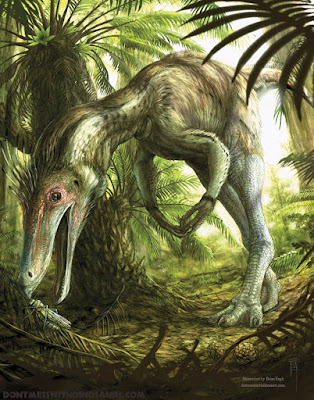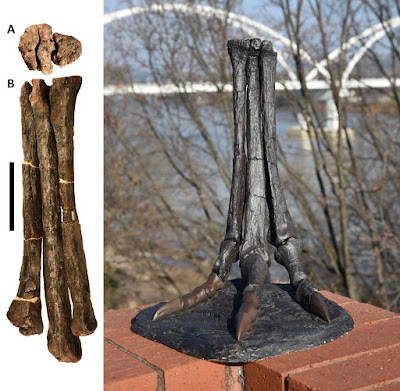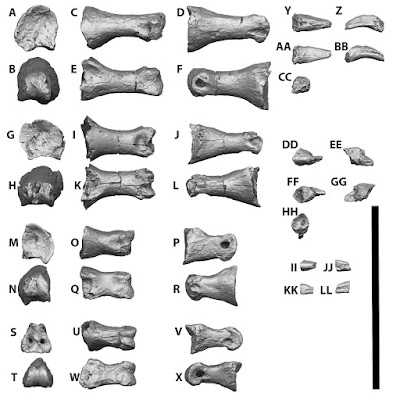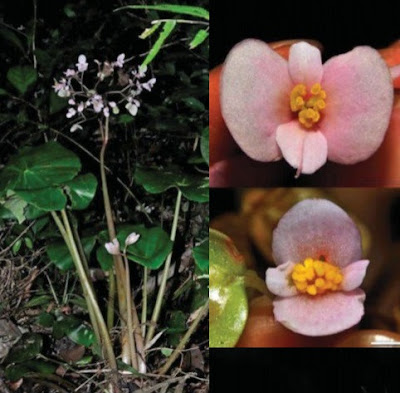[Most Recent Entries] [Calendar View]
Tuesday, March 20th, 2018
| Time | Event | ||||||
| 10:32a | [Paleontology • 2018] Arkansaurus fridayi • A New Ornithomimosaur from the Lower Cretaceous Trinity Group of Arkansas
ABSTRACT Whereas ornithomimosaurs (ostrich-mimic dinosaurs) are well known from Asia during the Early Cretaceous, they are less well known from this time in North America. Represented by a single specimen consisting of pedal elements, a new North American taxon, Arkansaurus fridayi, gen. et sp. nov., consists of a nearly complete right foot, recovered from the Lower Cretaceous (Albian–Aptian) Trinity Group of Arkansas. Arkansaurus fridayi can be distinguished from other ornithomimosaurs based on differentiated pedal unguals, a laterally compressed third metatarsal that is ovoid in proximal view, and a distal ungual with a very weak flexor tubercle, lacking spurs. The condition of this third metatarsal suggests that Arkansaurus fridayi is more basal than Asiatic ornithomimosaurs of similar age, but consistent with older North American forms. This specimen provides knowledge of a poorly understood radiation of ornithomimosaurs in Appalachia and is the only known saurischian dinosaurian fossil from the state of Arkansas.
SYSTEMATIC PALEONTOLOGY DINOSAURIA Owen, 1842 SAURISCHIA Seeley, 1887 THEROPODA Marsh, 1881; Gauthier, 1986 ORNITHOMIMOSAURIA Barsbold, 1976; Lee et al., 2014 ARKANSAURUS FRIDAYI, gen. et sp. nov. Etymology—The genus is named for the state of Arkansas, where the specimen was discovered. The species name is in honor of Joe B. Friday, who discovered the remains in 1972. ....
CONCLUSION: Arkansaurus fridayi currently is one of the oldest basal ornithomimosaurs known from North America. Its occurrence in the southeastern portion of the North American continent is significant biogeographically, because most of the Early Cretaceous basal ornithomimosaurs were flourishing in Asia at the time, but are otherwise not well represented in North America. Further discoveries of similar ornithomimosaur taxa in North America will provide better understanding of additional, currently unknown, characters. ReBecca K. Hunt and James H. Quinn. 2018. A New Ornithomimosaur from the Lower Cretaceous Trinity Group of Arkansas. Journal of Vertebrate Paleontology. DOI: 10.1080/02724634.2017.1421209 | ||||||
| 11:09a | [Botany • 2018] Begonia adamsensis • A New Species (sect. Baryandra, Begoniaceae) from Luzon Island, the Philippines Abstract Begonia adamsensis from the northern part of Luzon Island is described as a new species endemic to the Philippines. This is the latest addition to the Begonia sect. Baryandra, making the total of Philippine begonias in this section to 56 species. It resembles Begonia hernandioides because its leaves are peltate, with a broad base, acuminate tip, nearly entire margin, and a glabrous peduncle; however, it differs significantly from B. hernandioides because of its broadly ovate red stipule, pubescent petiole, elliptic peltate leaf, pubescent abaxial lamina, and 4 perianth segments in the carpellate flower. Only about 200 individuals were found in a 100-m area that is being developed as a tourist spot in the locality, hence Begonia adamsensis is hereby proposed as critically endangered. Keywords: Begonia, Baryandra, Philippines, Eudicots  Liezel M. Magtoto, Rosario R. Rubite and Celia Austria. 2018. Begonia adamsensis (sect. Baryandra, Begoniaceae), A New Species from Luzon Island, the Philippines. Phytotaxa. 343(3); 289–292. DOI: 10.11646/phytotaxa.343.3.10  |
| << Previous Day |
2018/03/20 [Calendar] |
Next Day >> |











